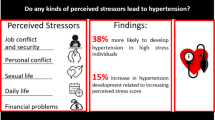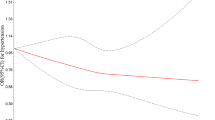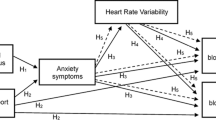Abstract
In order to investigate the relationship between perceived stress, anxiety, depression and hypertension in patients with essential hypertension, a case-control study was conducted among community residents. A total of 312 residents participated in the study by completing a self-reported questionnaire, 156 of whom were hypertensive patients and 156 were healthy. The questionnaire included demographic information, Perceived Stress Scale, Beck Anxiety Inventory and Beck Depression Inventory-II. The data were analyzed using t-test, correlation analysis, Logistic regression analysis, and structural equation modeling procedure to validate the mediation model. The results of Logistic regression analysis showed that anxiety (OR = 1.082, 95% CI 1.011–1.133, P < 0.01), depression (OR = 1.041, 95% CI 1.006–1.078, P < 0.05) and age (OR = 1.033, 95% CI 1.008–1.058, P < 0.01) were risk factors for hypotension, however, perceived stress (OR = 0.955, 95% CI 0.921–0.990, P < 0.05) was a protective factor against hypertension. Furthermore, structural equation model results reported that anxiety and depression play a mediating role between perceived stress and essential hypertension. These results suggest that anxiety and depression can raise the risk of developing essential hypertension. While the relationship between perceived stress and hypertension is still debated, it is well established that perceived stress can positively predict hypertension through the mediating role of anxiety and depression. Therefore, healthcare workers should take care of the mental health of patients and provide more psychological support to help them move away from negative emotions and better control their blood pressure.

Similar content being viewed by others
Data availability
The data that support the findings of this study are available from the corresponding author, upon reasonable request.
References
Baxter, A. J., Vos, T., Scott, K. M., Ferrari, A. J., & Whiteford, H. A. (2014). The global burden of anxiety disorders in 2010. Psychological Medicine, 44(11), 2363–2374. https://doi.org/10.1017/S0033291713003243
Beauducel, A., & Herzberg, P. Y. (2006). On the performance of maximum likelihood versus means and variance adjusted weighted least squares estimation in CFA. Structural Equation Modeling, 13(2), 186–203. https://doi.org/10.1207/s15328007sem1302_2
Beck, A. T., Epstein, N., Brown, G., & Steer, R. A. (1988). An inventory for measuring clinical anxiety: psychometric properties. Journal of Consulting and Clinical Psychology, 56(6), 893–897. https://doi.org/10.1037/0022-006X.56.6.893
Beck, A. T., Steer, R. A., & Brown, G. K. (1996). Manual for the beck depression inventory-second edition manual. Psychological Corporation.
Cohen, S., Kamarck, T., & Mermelstein, R. (1983). A global measure of perceived stress. Journal of Health and Social Behavior, 24, 385–396. https://doi.org/10.2307/2136404
Curis, C. (2019). Stress, psychosomatic disorders and thanatophobia syndrome. ICOANA CREDINTEI. International Journal of Interdisciplinary Scientific Research, 5(9), 79–83.
Davidson, K., Jonas, B. S., Dixon, K. E., & Markovitz, J. H. (2000). Do depression symptoms predict early hypertension incidence in young adults in the CARDIA study? Archives of Internal Medicine, 160(10), 1495–1500. https://doi.org/10.1001/archinte.160.10.1495
Gao, S. N., Ji, Y. F., Yin, L. H., Wang, F., Lu, H. M., & Wu, J. H. (2014). The prevalence and epidemical trend of hypertension and healthy behavior in Luwan District, Shanghai. Modern Preventive Medicine, 41(1), 90–93.
Ghazi, L., Oparil, S., Calhoun, D. A., Lin, C. P., & Dudenbostel, T. (2017). Distinctive risk factors and phenotype of younger patients with resistant hypertension: age is relevant. Hypertension, 69(5), 827–835. https://doi.org/10.1161/HYPERTENSIONAHA.116.08632
Haji-Mirsaeidi, Z., Kazemi-Zahrani, H., & Sadeghi, M. (2016). Comparison of the mindfulness skills, metacognitive beliefs and perceived stress in hypertension patients and control group. Global Journal of Health Science, 9(1), 138. https://doi.org/10.5539/gjhs.v9n1p138
Hering, D., Marusic, P., Walton, A. S., Lambert, E. A., Krum, H., Narkiewicz, K., Lambert, G. W., Esler, M. D., & Schlaich, M. P. (2014). Sustained sympathetic and blood pressure reduction 1 year after renal denervation in patients with resistant hypertension. Hypertension, 64(1), 118–124. https://doi.org/10.1161/HYPERTENSIONAHA.113.03098
Huang, Z., Jiang, G., Huang, H., & Zhang, H. Q. (2010). Analysis of mental status of elderly hypertensive patients in Shenzhen VIC. Chinese General Practice, (8), 1020–1021.
Jackson, C. A., Pathirana, T., & Gardiner, P. A. (2016). Depression, anxiety and risk of hypertension in mid-aged women: a prospective longitudinal study. Journal of Hypertension, 34(10), 1959–1966. https://doi.org/10.1097/HJH.0000000000001030
Jonas, B. S., Franks, P., & Ingram, D. D. (1997). Are symptoms of anxiety and depression risk factors for hypertension? Longitudinal evidence from the national health and nutrition examination survey I epidemiologic follow-up study. Archives of Family Medicine, 6(1), 43–49. https://doi.org/10.1001/archfami.6.1.43
Johnson, H. M. (2019). Anxiety and hypertension: is there a link? A literature review of the comorbidity relationship between anxiety and hypertension. Current Hypertension Reports, 21(9), 1–7. https://doi.org/10.1007/s11906-019-0972-5
Korhonen, P. (2016). Hypertension and depression - the terrible two. Arterial Hypertension, 20(4), 198–199. https://doi.org/10.5603/AH.2016.0021
Kurnianto, A., Sunjaya, D. K., Rinawan, F. R., & Hilmanto, D. (2020). Prevalence of hypertension and its associated factors among indonesian adolescents. International Journal of Hypertension, 1–7. https://doi.org/10.1155/2020/4262034
Lazarus, R. S., & Folkman, S. (1984). Stress, appraisal and coping. Springer.
Lee, J., Weiss, A., Ford, C. G., Conyers, D., & Shook, N. J. (2022). The indirect effect of trait mindfulness on life satisfaction through self-esteem and perceived stress. Current Psychology. https://doi.org/10.1007/s12144-021-02586-7
Li, D., Rong, C., & Kang, Q. (2022). Association between perceived stress and hypertension in chinese adults: a population-based survey. Journal of Human Hypertension, 8(4). https://doi.org/10.1038/s41371-022-00684-y
Li, Z., Li, Y., Chen, L., Chen, P., Hu, Y., & Wang, H. (2015). Prevalence of depression in patients with hypertension: a systematic review and meta-analysis. Medicine (Baltimore), 94(31), e1317. https://doi.org/10.1097/MD.0000000000001317
Logan, J. G., Barksdale, D. J., Carlson, J., Carlson, B. W., & Rowsey, P. J. (2012). Psychological stress and arterial stiffness in Korean Americans. Journal of Psychosomatic Research, 73(1), 53–58. https://doi.org/10.1016/j.jpsychores.2012.04.008
Ma, L. Y., Wang, Z. W., Fan, J. & Hu, S. S. (2022). Epidemiology and management of hypertension in China: An analysis using data from the annual report on cardiovascular health and diseases in China (2021). Chinese General Practice, 25(30), 3715–3720. https://doi.org/10.12114/j.issn.1007-9572.2022.0502
Maatouk, I., Herzog, W., Böhlen, F., Quinzler, R., Löwe, B., Saum, K., Brenner, H., & Wild, B. (2016). Association of hypertension with depression and generalized anxiety symptoms in a large population-based sample of older adults. Journal of Hypertension, 34(9), 1711–1720. https://doi.org/10.1097/HJH.0000000000001006
Meng, L., Chen, D., Yang, Y., Zheng, Y., & Hui, R. (2012). Depression increases the risk of hypertension incidence: a meta-analysis of prospective cohort studies. Journal of Hypertension, 30(5), 842–851. https://doi.org/10.1097/HJH.0b013e32835080b7
Meyer, C. M., Armenian, H. K., Eaton, W. W., & Ford, D. E. (2004). Incident hypertension associated with depression in the Baltimore epidemiologic catchment area follow-up study. Journal of Affective Disorders, 83(2), 127–133. https://doi.org/10.1016/j.jad.2004.06.004
Moussavi, S., Chatterji, S., Verdes, E., Tandon, A., Patel, V., & Ustun, B. (2007). Depression, chronic diseases, and decrements in health: Results from the world health surveys. The Lancet (British Edition), 370(9590), 851–858. https://doi.org/10.1016/S0140-6736(07)61415-9
Muthén, B. O. (1993). Goodness of fit with categorical and other non-normal variables. In K. A. Bollen & J. S. Long (Eds.), Testing structural equation models. Sage.
Pan, Y., Cai, W., Cheng, Q., Dong, W., An, T., & Yan, J. (2015). Association between anxiety and hypertension: A systematic review and meta-analysis of epidemiological studies. Neuropsychiatric Disease and Treatment, (11), 1121–1130.
Player, M. S., & Peterson, L. E. (2011). Anxiety disorders, hypertension, and cardiovascular risk: a review. International Journal of Psychiatry in Medicine, 41(4), 365–377. https://doi.org/10.2190/PM.41.4.f
Räikkönen, K., Matthews, K. A., Flory, J. D., & Owens, J. F. (1999). Effects of hostility on ambulatory blood pressure and mood during daily living in healthy adults. Health Psychology, 18(1), 44–53. https://doi.org/10.1037/0278-6133.18.1.44
Scalco, A. Z., Scalco, M. Z., Azul, J. B. S., & Neto, L. (2005). Hypertension and depression. Clinics (São Paulo Brazil), 60(3), 241–250. https://doi.org/10.1590/S1807-59322005000300010
Silverman, W. K., & van Schalkwyk, G. I. (2019). What is anxiety? Pediatric anxiety disorders, 7–16. https://doi.org/10.1016/B978-0-12-813004-9.00002-5
Tian, Y., Chen, J., Wang, H. P., & Meng, Q. Y. (2014). Analysis on dynamic trend of hypertension in chinese adults in 1991–2009. Chinese Preventive Medicine, 2, 138–142.
Wang, Z., Chen, Z., Zhang, L., Wang, X., Hao, G., Zhang, Z., Shao, L., Tian, Y., Dong, Y., Zheng, C., Wang, J., Zhu, M., Weintraub, W. S., Gao, R. & On behalf of the China Hypertension Survey Investigators. (2018). Status of hypertension in China: Results from the China hypertension survey, 2012–2015. Circulation, 137(22), 2344–2356. https://doi.org/10.1161/CIRCULATIONAHA.117.032380
Wang, Z., Yuan, C. M., Huang, J., Li, Z. Z., Chen, Y., Zhang, H. Y., Fang, Y. R., & Xiao, Z. P. (2011). Reliability and validity of the chinese version of Beck Depression Inventory-II among depression patients. Chinese Mental Health Journal, 25(6), 476–480. https://doi.org/10.3969/j.issn.1000-6729.2011.06.014
Wen, Z. L., & Liu, H. Y. (2020). Analysis of mediating and moderating effects: methods and applications. Educational Science Publishing House.
WHO (2022a). World Health Statistics 2022, World Health Organization, 50. https://apps.who.int/iris/rest/bitstreams/1435584/retrieve. Accessed 21 Nov 2022
WHO (2022b). Depression. World Health Organization. https://www.who.int/health-topics/depression#tab=tab_1. Accessed 21 Nov 2022
Wiernik, E., Pannier, B., Czernichow, S., Nabi, H., Hanon, O., Simon, T., Simon, J., Thomas, F., Bean, K., Consoli, S. M., Danchin, N., & Lemogne, C. (2013). Occupational status moderates the association between current perceived stress and high blood pressure: Evidence from the IPC cohort study. Hypertension, 61(3), 571–577. https://doi.org/10.1161/HYPERTENSIONAHA.111.00302
Wilson, K. A., Chambless, D. L., & Beurs, E. D. (2017). Beck anxiety inventory. Springer International Publishing.
Wu, Y. F. (2014). Depressive symptoms in the Elderly with hypertension and their influencing factors. (Research Dissertation, Central South University).
Yang, T. Z., & Huang, H. T. (2003). An epidemiological study on stress among urban residents in social transition period. Chinese Journal of Epidemiology, 24(9), 760–764. https://doi.org/10.3760/j.issn:0254-6450.2003.09.004
Zhang, M., Wu, J., Zhang, X., Hu, C. H., Zhao, Z. P., Li, C., Huang, Z. J., Zhou, M. G., & Wang, L. M. (2021). Prevalence and control of hypertension in adults in China, 2018. Chinese Journal of Epidemiology, 42(10), 1780–1789. https://doi.org/10.3760/cma.j.cn112338-20210508-00379
Zheng, J. R., Huang, C. R., Huang, J. J., Zhuang, X. Q., Wang, D. B., Zheng, S. Y., Huang, X. Y., Chen, Q. Y., & Wu, J. A. (2002). A study of Psychometric Properties, normative scores and factor structure of Beck anxiety Inventory Chinese Version. Chinese Journal of Clinical Psychology, 10(1), 4–6. https://doi.org/10.3969/j.issn.1005-3611.2002.01.002
Acknowledgements
We would like to thank the community hospital of Peking University Health Science Center for allowing us to recruit participants, and thank all research staff and participants of this study.
Funding
This study was funded by the Major Projects of Beijing Municipal Science & Technology Commission (D151100002315004).
Author information
Authors and Affiliations
Contributions
Yan Lv, Data curation, Investigation, Supervision, Roles/Writing - original draft.
Shuwei Hao, Conceptualization, Methodology, Project administration, Writing - review & editing.
Corresponding author
Ethics declarations
Conflict of interest
The authors declare that they have no conflict of interest.
Additional information
Publisher’s note
Springer Nature remains neutral with regard to jurisdictional claims in published maps and institutional affiliations.
Rights and permissions
Springer Nature or its licensor (e.g. a society or other partner) holds exclusive rights to this article under a publishing agreement with the author(s) or other rightsholder(s); author self-archiving of the accepted manuscript version of this article is solely governed by the terms of such publishing agreement and applicable law.
About this article
Cite this article
Lv, Y., Hao, S. Mediating role of anxiety and depression in the relationship between perceived stress and essential hypertension. Curr Psychol 42, 30780–30787 (2023). https://doi.org/10.1007/s12144-022-04098-4
Accepted:
Published:
Issue Date:
DOI: https://doi.org/10.1007/s12144-022-04098-4




